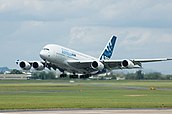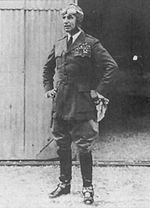Portal:Aviation
| Main page | Categories & Main topics |
|
Tasks and Projects |
The Aviation Portal

Aviation includes the activities surrounding mechanical flight and the aircraft industry. Aircraft includes fixed-wing and rotary-wing types, morphable wings, wing-less lifting bodies, as well as lighter-than-air craft such as hot air balloons and airships.
Aviation began in the 18th century with the development of the hot air balloon, an apparatus capable of atmospheric displacement through buoyancy. Some of the most significant advancements in aviation technology came with the controlled gliding flying of Otto Lilienthal in 1896; then a large step in significance came with the construction of the first powered airplane by the Wright brothers in the early 1900s. Since that time, aviation has been technologically revolutionized by the introduction of the jet which permitted a major form of transport throughout the world. (Full article...)
Selected article
Selected image
Did you know
...that the pioneer American airman Lowell Smith participated in the first mid-air refueling, the first aerial circumnavigation and held 16 records for military aircraft in speed, endurance and distance? ..that Elm Farm Ollie in 1930 became the first cow to be milked while flying in an airplane? ... that the PZL SM-4 Łątka never flew, because its engine was not approved for use in flight?
General images -
In the news
- May 29: Austrian Airlines cancels Moscow-bound flight after Russia refuses a reroute outside Belarusian airspace
- August 8: Passenger flight crashes upon landing at Calicut airport in India
- June 4: Power firm helicopter strikes cables, crashes near Fairfield, California
- January 29: Former basketball player Kobe Bryant dies in helicopter crash, aged 41
- January 13: Iran admits downing Ukrainian jet, cites 'human error'
- January 10: Fire erupts in parking structure at Sola Airport, Norway
- October 27: US announces restrictions on flying to Cuba
- October 3: World War II era plane crashes in Connecticut, US, killing at least seven
- September 10: Nevada prop plane crash near Las Vegas leaves two dead, three injured
- August 6: French inventor Franky Zapata successfully crosses English Channel on jet-powered hoverboard
Related portals
Associated Wikimedia
The following Wikimedia Foundation sister projects provide more on this subject:
-
Commons
Free media repository -
Wikibooks
Free textbooks and manuals -
Wikidata
Free knowledge base -
Wikinews
Free-content news -
Wikiquote
Collection of quotations -
Wikisource
Free-content library -
Wikiversity
Free learning tools -
Wikivoyage
Free travel guide -
Wiktionary
Dictionary and thesaurus
Selected biography
Mitchell deployed to France in 1917 when the United States entered World War I. While there he was promoted to brigadier general and placed in command American combat air units in France. After the war Mitchell was appointed the deputy director of the Air Service became a passionate advocate of air power. In 1921 he set up a demonstration to show the capability of airpower against naval vessels. During the course of the demonstrations aircraft successfully sank a captured German destroyer, the light crusier Frankfurt, and the battleship Ostfriesland.
Mitchell regularly sparred with his superiors over the role of airpower in the military. In 1925 he was reverted to his permanent rank of colonel and was transferred to San Antonio, Texas. Later that year, after a series of aviation accidents he accused Army and Navy leadership of incompetence and "almost treasonable administration of the national defense." In response he was court-martialed for insubordination, found guilty, and sentenced to a five-year suspension from active duty. Mitchell resigned on 1 February 1926 in lieu of serving the sentence. He continued to advocate airpower as a civilian until his death in 1936. In 1942 President Franklin Roosevelt posthumously promoted Mitchell to major general in recognition of his contributions to air power.
Selected Aircraft
[[File:|right|250px|]] The Tupolev TB-3 (Russian: Тяжёлый Бомбардировщик, Tyazholy Bombardirovschik, Heavy Bomber, civilian designation ANT-6) was a heavy bomber aircraft which was deployed by the Soviet Air Force in the 1930s and during World War II. It was the world's first cantilever wing four-engine heavy bomber. Despite obsolescence and being officially withdrawn from service in 1939, TB-3 performed bomber and transport duties through much of WWII. The TB-3 also saw combat as a Zveno project fighter mothership and as a light tank transport.
- Span: 41.80 m (137 ft 2 in)
- Length: 24.4 m (80 ft 1 in)
- Height: 8.50 m (27 ft 11 in)
- Engines: 4× Mikulin M-17F V12 engines, 525 kW (705 hp) each
- Maximum Speed: 196 km/h (106 knots, 122 mph) at 3000 m (9,840 ft)
- First Flight: 22 December 1930
Today in Aviation
- 2009 – Myanma Airways Flight 409, a Fokker F28-4000, registration XY-ADW, overruns the runway at Sittwe Airport, Myanmar. The aircraft is damaged beyond repair.
- 2004 – Alaska Airlines starts service between Denver and Anchorage and discontinues service between San Jose and Tucson.
- 1994 – China Northwest Airlines Flight 2303, a Tupolev Tu-154M, breaks up in mid-air and crashes near Xian, China, killing all 160 on board. The deadliest airplane crash ever to occur in China is attributed to a maintenance error.
- 1992 – Copa Airlines Flight 201, a Boeing 737-200 Advanced, crashes near Darién, Panama, killing all 47 passengers and crew on board; a faulty attitude indicator is the cause.
- 1982 – Aeroflot Flight 411, an Ilyushin Il-62, crashes after take-off from Sheremetyevo International Airport; all 90 on board are killed.
- 1982 – Westland Gazelle AH1 XX377 is shot down by friendly fire from HMS Cardiff during the Falklands War
- 1976 – Royal Air force receives first F-16.
- 1976 – The Double Six Tragedy, also known as the Double Six Crash, was a plane crash in Kota Kinabalu, Malaysia. The plane, operated by Sabah Air, coming from Labuan crashed in the sub-district of Sembulan in Kota Kinabalu upon approaching Kota Kinabalu International Airport. The crash killed everyone on board the flight, including Tun Fuad Stephens, the Chief Minister of Sabah at that time.
- 1973 – The 1973 Paris Air Show crash was the crash of the second production Tupolev Tu-144 at Goussainville, Val-d’Oise, France, which killed all six crew and a further eight people on the ground. The crash, at the Paris Air Show, damaged the development program of the Tupolev Tu-144. One theory is that a French Mirage jet sent to photograph the aircraft without the knowledge of the Russian crew caused the pilots to take evasive maneuvers, resulting in the crash. Another theory is that in a rivalry with the Anglo-French Concorde, the pilots attempted a maneuver that was beyond the capabilities of the aircraft.
- 1971 – A United States Marine Corps McDonnell-Douglas F-4B Phantom II fighter jet collides with Hughes Airwest Flight 706, a Douglas DC-9, which crashes into the San Gabriel Mountains near Duarte, California, killing all 49 people aboard; the pilot of the Phantom also dies, while his radar intercept officer successfully bails out.
- 1970 – A USAF Lockheed C-5A Galaxy, 68-0212, c/n 500-0015, fifteenth off the production line, but first to be delivered to any operational Military Airlift Command wing, loses one tire and blows another on landing at Charleston AFB, South Carolina for the 437th MAW.
- 1967 – First transcontinental carrier-to-carrier jet flight. From USS Bonhomme Richard in the Pacific to USS Saratoga in the Atlantic, 03 h:28 m, in a Vought F8U Crusader flown by USN Capt Robert Dose & LCdr Paul Miller. Distance unstated.
- 1966 – Gemini 9 landed in the Pacific after 45 orbits of Earth during the 72 h 20 min flight.
- 1964 – Over Laos, Pathet Lao antiaircraft artillery shoots down a U. S. Navy RF-8 A Crusader photographic reconnaissance aircraft piloted by Lieutenant Charles F. Klusmann. It is the first U. S. Navy aircraft and first American fixed-wing aircraft lost over Indochina in the Vietnam War era.
- 1964 – The historic aircraft collections of the Canadian War Museum, National Aviation Museum, and the Royal Canadian Air Force were displayed together for the first time at the Rockcliffe RCAF Station. The three collections together were designated the National Aeronautical Collection.
- 1964 – Silver City Airline announces that it has airlifted its one millionth car between England and continental Europe.
- 1945 – The Boeing B-29 Superfortress that led the first B-29 raid on Tokyo on 24 November 1944, 42-24592, named "Dauntless Dotty", of the 869th Bomb Squadron, 497th Bomb Group, 73rd Bomb Wing, 20th Air Force, departs Kwajalein at 0306 hrs. for the second leg of a ferry flight back to the United States, commanded by Capt. William A. Kelley, of Tifton, Georgia. Forty seconds after takeoff, the aircraft strikes the Pacific Ocean and sinks, killing 10 of 13 on board instantly. Co-pilot 1st Lt. John Neville, of Bradley, Illinois, tailgunner S/Sgt. Glenn F. Gregory, of Waldron, Illinois, and left gunner S/Sgt. Charles McMurray (also spelt McMurry in one source), of Memphis, Tennessee, are thrown from the wreckage and are recovered by a rescue boat after some 45 minutes in the water. A search for the lost airframe by the National Underwater and Marine Agency Australia has been proposed.
- 1944 – A huge airborne armada, nine planes wide and 200 miles long, carries American and British troops across the British Channel for the D-Day invasion of Europe.
- 1944 – Thirty-seven RCAF bomber, fighter and coastal squadrons took part in operations for the invasion of Normandy. The Allied invasion of France is spearheaded by paratrooper drops and assault glider landings. The Luftwaffe offers almost no resistance to the invasion.
- 1944 – First flight of the Lockheed XP-58 Chain Lightning was on 6 Jun 1944 at the Lockheed Burbank Plant.
- 1943 – (6-9) Allied aircraft drop an average of 600 tons (544,316 kg) of bombs per day on Pantelleria
- 1942 – The first nylon parachute jump occurred (Hartford, Ct).
- 1942 – Flying 112 sorties, carrier aircraft from Enterprise and Hornet sink the Japanese heavy cruiser Mikuma as she withdraws from the Midway area, bringing the Battle of Midway to an end. Three TBD Devastators participate; it is the last combat flight of the Devastator.
- 1942 – Four U. S. Army Forces B-24 Liberator bombers led by Major General Clarence L. Tinker take off from Midway to attack the Japanese bomber base on Wake Island. Tinker’s plane disappears after take-off and no wreckage or bodies are ever found.
- 1939 – Adolf Hitler reviews 14,000 veterans of the Luftwaffe’s Condor Legion in Berlin.
- 1936 – Aviation gasoline first produced commercially Paulsboro NJ.
- 1932 – First flight of the Armstrong Whitworth Atalanta
- 1931 – Barker Field was opened at Toronto by Mrs. W. G. Barker and L/Col W. A. Bishop.
- 1927 – Canadian innovator Wallace Turnbull sells the parent of the variable-pitch propeller to Curtiss-Wright in the United States and Bristol in the United Kingdom. It will be successfully flight tested on June 29.
- 1917 – The world’s first landplane designed for use as a torpedo bomber, a Sopwith Cuckoo, is completed for the Royal Naval Air Service.
- 1915 – LZ 37 becomes the first Zeppelin destroyed in air-to-air combat when it is bombed by Flt Sub-Lt Reginald Warneford, RNAS.
- 1914 – First air flight out of sight of land (Scotland to Norway).
- 1910 – Robert Martinet wins the first cross-country air race, between Angers and Saumur, France (27 miles), in a Farman; he takes 31 min and 35 seconds.
- 1905 – Gabriel Voisin flies along the River Seine in his float-glider towed by a motorboat.
- 1903 – After several stationary stability trials, Ferdinand Ferber makes the first full trial of his glider No.6. It fails to take off in Nice, France.
References
- Shortcuts to this page: Portal:Airplanes • P:AVIA





















































